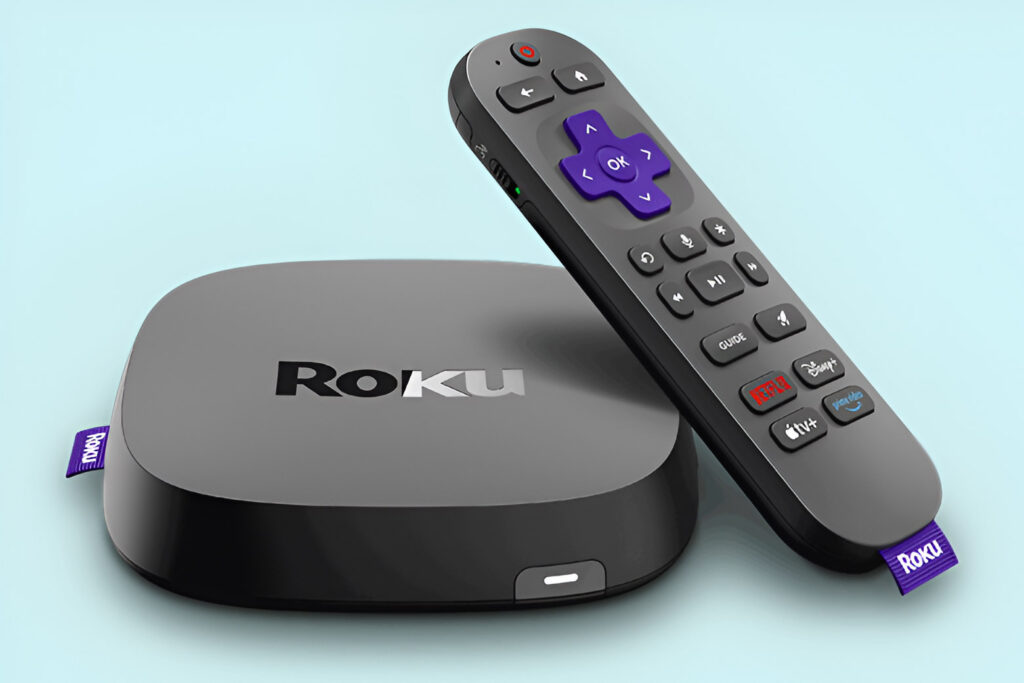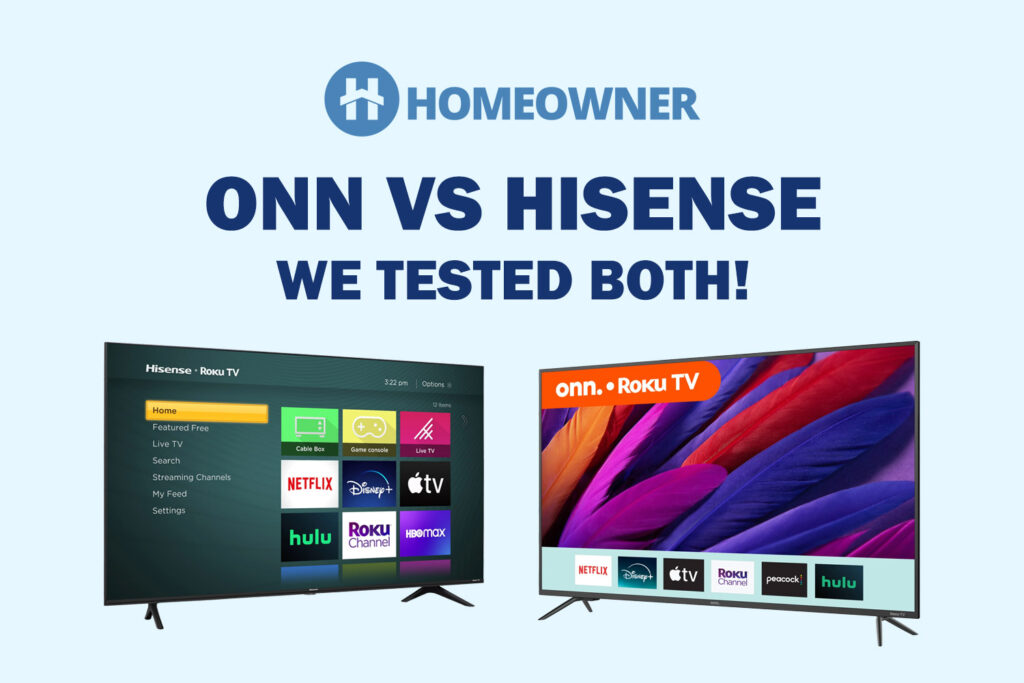Getting proper wireless connectivity in a house as big as 3,000 Sq Ft isn’t easy, especially with ISP-supplied equipment. Their inferior features leave many WiFi dead zones besides frequent signal drops in certain parts of the house, such as the basement or kitchen.
That's why I tested 17 different options, including modem/router combos, mesh WiFi systems, and standalone WiFi routers.
Based on my testing, I came to a few realizations:
- WiFi mesh systems are the ultimate solution for large homes with thick walls, gigabit connections, or multi-story houses. But they're pretty expensive.
- Don't get modem/router combos because they're two devices crammed into a single box, so even if the coverage range mentions 3,000 Sq Ft, they won't make it in practical scenarios, and there'll be performance issues.
- If you're on a low budget, get a dual-band or tri-band router with coverage of 2,000 Sq Ft and use a wireless extender for areas where the router can't pass signals.
- And importantly, ensure you get a router that can handle speeds according to your internet plan. For instance, if you're on a 500 Mbps plan, get a router that can get you speeds between 700-900 Mbps, or else with multiple devices connected, you might experience internet throttling or overheating.
The options might be scarce, but finding the best router for a 3,000 Sq Ft house can be challenging. Fret not; the below-listed options shall suit your needs best in 2025:
- Best Long-Range Router: Netgear RAXE500
- Best Gaming Router: ASUS GT-AX11000
- Best For Thick Walls: TP-Link Archer GX90
- Best Value for Money: Linksys MR9610
- Best Mesh System: Amazon Eero 6+
- Best Budget Option: ASUS RT-AX55
Despite the lengthy specs sheet, the real-life performance differs. I've purchased and tested many models to determine their competence in transmitting signals to a far distance. And finally, here to review my top 6 choices for 3,000 Sq Ft homes.
In the subsequent sections, I will share my honest experiences using these models concerning their coverage, signal quality, wireless and wired speeds, network stability, and security features. Also, I've ensured you get multiple choices from premium to mid-range and budget options at the end. So, read through them and make an informed decision.
1. Best Overall: Netgear Nighthawk RAXE500
If you're living in a single-floor apartment, then no router in the market can provide performance as good as the RAXE500. The coverage area mentioned is 3,500 Sq Ft, but your apartment would have walls that can weaken the signals.
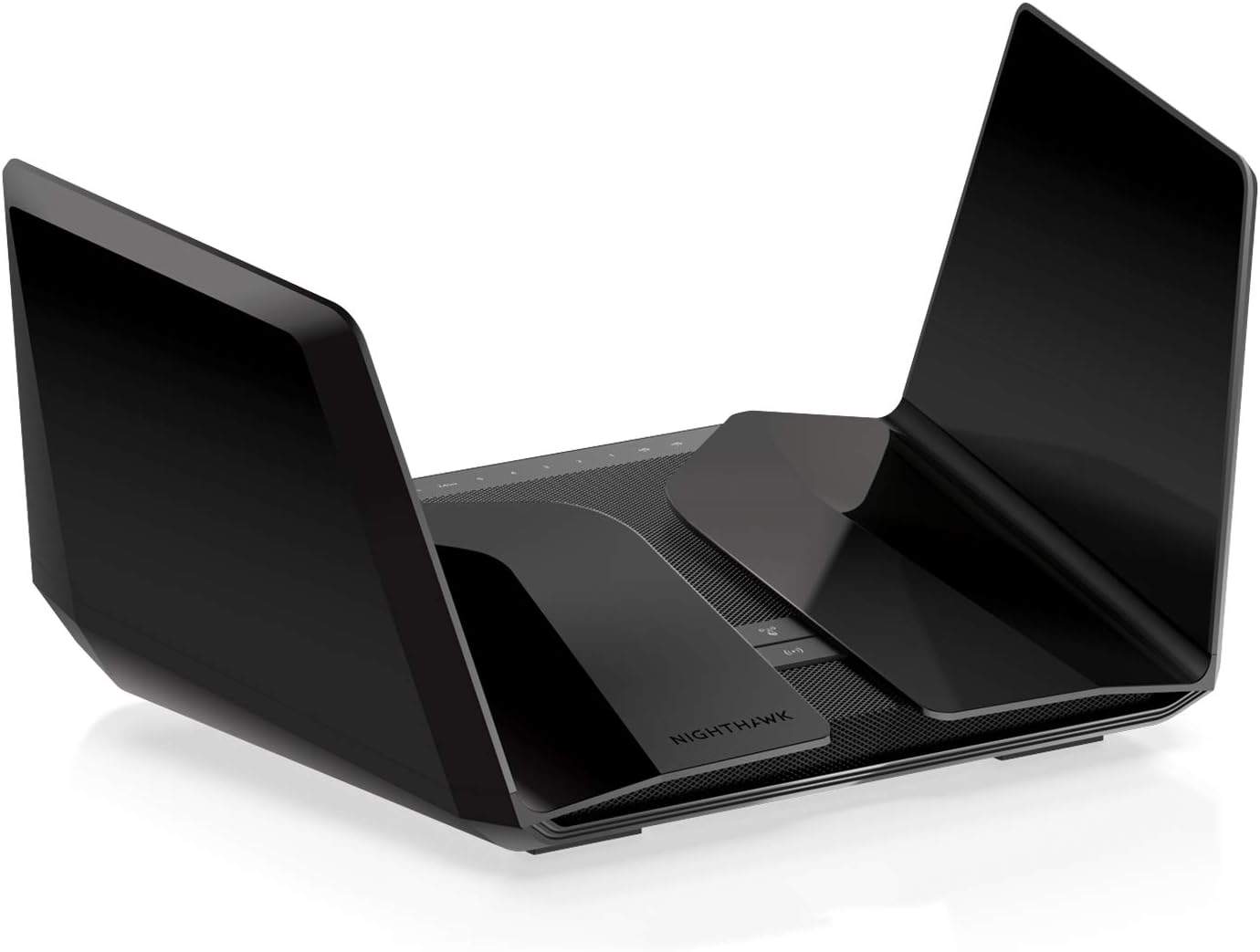
- WiFi Range: Up to 3,500 Sq Ft
- Wireless Standard: Wi-Fi 6E
- Suitable Plan: Up to 2 Gbps
- 2.4GHz Speeds: 1200 Mbps
- 5GHz Speeds: 4800 Mbps
- 6GHz Speeds: 4800 Mbps
- Number of Devices Supported: 60
- Ports: 1 x 2.5G LAN + 1 x Gig WAN + 4 x Gig LAN + 2 x USB 3.0
- Processor: 1.8GHz Quad-core processor
- RAM & NAND Memory: 1GB + 512MB
- App Support: Yes
If you want an exquisite-looking router with high-end features to fulfill your high-bandwidth needs, get the Netgear RAXE500. With WiFi 6E support, the new 6 GHz band combined with a 1.8GHz processor delivers the performance of dreams.
Compared to its older model, Nighthawk RAXE7800, it’s a massive upgrade in terms of maximum speeds, hardware specifications, and coverage, but a bit expensive too.
Why is it suited for a 3,000 Sq Ft House?
RAXE500’s design is inspired by an alien mothership whose wings act as antennas to cover your whole 3,000 Sq Ft house with solid connectivity.
Despite keeping it in the corner room of the second floor, there was no lingering connection in any nooks. And while kept at the center, it even lit up the garage smart light of my friend’s 3,000 Sq Ft house, taking its range to almost 3,200 Sq Ft.
Other than that, courtesy of technologies like MU-MIMO and OFDMA, wireless connections to client devices are bulletproof. The signal didn’t even drop once during the time. I had around 45 connections all the time, most of which were smart devices, including TVs, computers, laptops, and gaming consoles.
Wireless Speeds
With a robust hardware setup and the latest WiFi 6E standard, and an additional 6 GHz band working together, you won’t have to worry about running out of bandwidth anytime. In my tests over a 2 Gig Xfinity plan, the download speeds over the 5GHz band averaged 1.97 Gbps, while uploads happened at 325 Mbps.
The speeds over the 2.4GHz band were also fine, with download and upload speed scores at 1198 Mbps and 305 Mbps, respectively. In short, with lightning-fast speeds from RAXE500, you breeze through any internet-bound tasks, whether 8K streaming, AR/VR gaming, or video calls on multiple devices.
Wired Speeds
Netgear RAXE500 also excels in this department with one 2.5G WAN port and four Gig LAN ports. The latter also supports link aggregation but requires merging two separate IPs. Also, you can connect your device to the 2.5G port to access multi-gig speeds, with a maximum of 2.1 Gbps for downloads and 389 Mbps for uploads.
So, if there’s a need for extra bandwidth, plug your devices directly into the device.
Security Features
Security is an area that might have improved. You get features like WPA3, guest network access, 128-bit AES encryption, and VPN support to keep your network secure. Alongside, its smart parental controls with features like managing online time, monitoring activities, creating separate profiles, foster healthy internet habits amongst children.
But advanced features like malware blocking and preventing cyber attacks aren’t available for free. It requires subscribing to a $6.99 monthly Netgear Armor subscription. You may check the features, use a 30-Day trial and decide if it's worth it.
Conclusion
Netgear RAXE500 is the most powerful router for a 3,000 Sq Ft house that combines top-of-the-line features and high performance. Its 2.5G WAN is a symbol of its multi-gig capabilities. Its only limitation is its premium pricing, but the features it boasts make it worth every penny. For more, consider reading the full RAXE500 review.
Pros
- Wi-Fi 6E with 6 GHz band
- Handles multi-gig internet plans
- Lightning-fast speeds
- Exceptional WiFi coverage
- Robust hardware configuration
Cons
- Advanced security needs a subscription
- Expensive
2. Best For Gaming: ASUS ROG GT-AX11000
Are you a gamer or streamer searching for a long-range wireless router that doesn't compromise on features and latency? Check out Asus GT-AX11000.
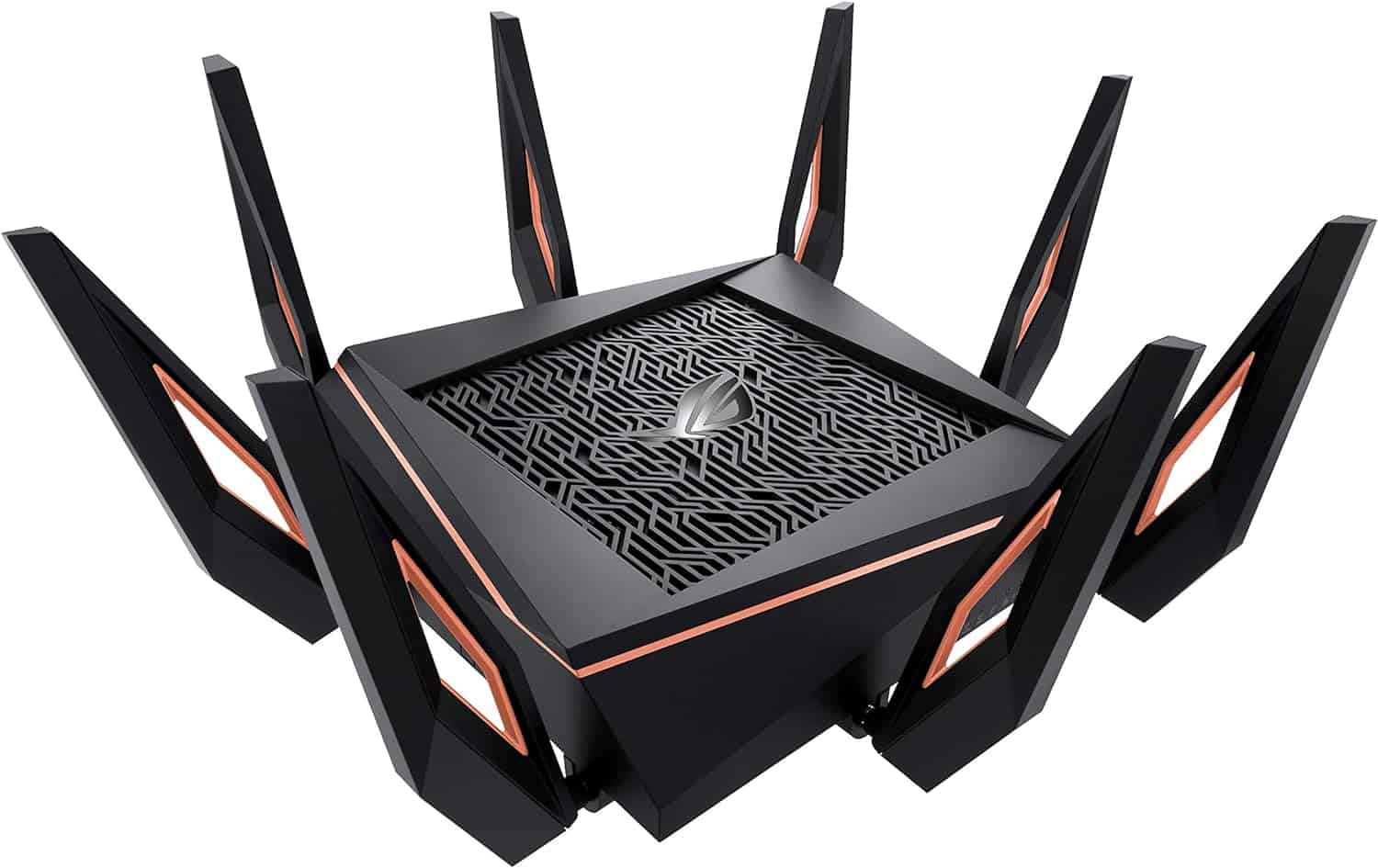
- WiFi Range: Up to 3,500 Sq Ft
- Wireless Standard: Wi-Fi 6 (802.11ax)
- Suitable Plan: Up to 2 Gbps
- 2.4GHz Speeds: 1148 Mbps
- 5GHz Speeds: 4804 + 4804 Mbps
- Number of Devices Supported: 100+
- Ports: 1 x 2.5G LAN + 1 x Gig WAN + 4 x Gig LAN + 2 x USB 3.1
- Processor: 1.8GHz Quad-Core
- RAM & NAND Memory: 1GB + 256MB
- App Support: Yes
Taking the second position amongst the best 3,000 Sq Ft routers is a gaming-centric device, ASUS ROG GT-AX11000. There are features like Tri-Band, Wi-Fi 6, cutting-edge hardware, and a 2.5 Gbps WAN port. Besides, the manufacturer has made several tweaks and gaming-related customizations, making it a major upgrade over ROG GT-AX6000.
Why is it suited for a 3,000 Sq Ft House?
Boasting an additional 5GHz band makes 15 channels accessible, so data packets can travel through less congestion, leading to an almost 80% increase in coverage. Alongside boasting an 8 external antenna setup, its signals could easily reach an area of 3,500 Sq Ft. This device also keeps the outskirts of your property encased with powerful signals.
The router boasts networking technologies like beamforming and OFDMA to deliver rock-solid signals to your devices. It means that connecting multiple devices concurrently won’t interrupt your gaming experience. I hosted a gaming tournament with 50 friends, and there was never a lag during the entire event.
Wireless Speeds
Possessing an additional 5GHz band gets you more precise signals, and pairing a 2 Gbps Xfinity plan delivered download and upload speeds of 1.95 Gbps and 368 Mbps. Similarly, the respective speeds on the 2.4GHz band stayed at around 1102 Mbps and 302 Mbps.
Besides, the router provides a triple-level game acceleration to minimize your ping time (around 2-3ms) and game latency to boost your gaming experience. I played Call of Duty: Warzone on my PC at 124 FPS with my friends, along with 4K streaming on the TV. The gameplay was smooth as a milk cream throughout my playtime, and I never missed a bullet from the back.
Wired Speeds
Considering the exceptional wireless capabilities, you might not need support from Gigabit ports to play no-lag games. But if you still have any additional devices to play on, get them connected to the 2.5G gaming port, and get effortless gaming with an increased fps value to 130 and a ping staying around 1ms mostly.
Even downloads and uploads were a bit faster, with values at 1.99 Gbps and 400 Mbps, respectively.
Security Features
Asus GT-AX11000 scores 5/5 in this department with its lifetime-free AiProtection subscription. Aside from basic features like guest access, VPN, WPA3, and port forwarding, there are some advanced ones like malware protection, website auto-blocking, and preventing unauthorized access. So, you can play games without worrying about compromising your network or device.
With respect to parental controls, features like WiFi pausing, scheduled pausing, age-appropriate filters, and website blocking give digital mothers the power to control what their kids are doing online.
Conclusion
To conclude, GT-AX11000 is a powerful gaming router that can cover a 3,000 Sq Ft house with ease. Built on battle-ready hardware, Wi-Fi 6 tri-band functionality, and gaming-oriented specs deliver next-level performance. Also, your network is safe from external threats with lifetime free security. But the lack of a 6GHz band has made it a runner-up pick.
Pros
- WiFi 6 Tri-Band functionality
- Long wireless coverage
- Game boost features
- Multi-gig speeds support
- Lifetime-free security suite
- Robust hardware
Cons
- Premium price
3. Best For Thick Walls: TP-Link Archer GX90
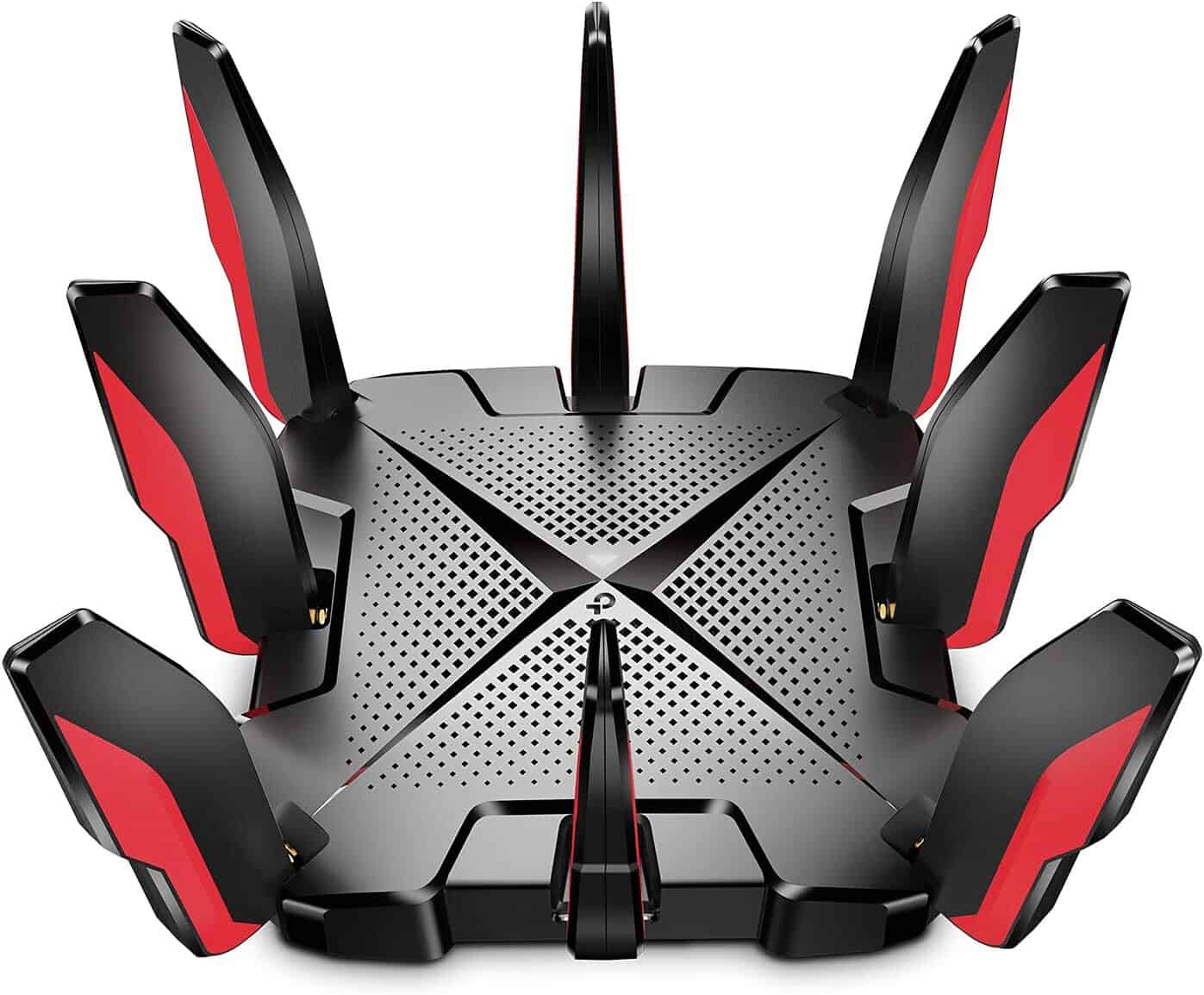
- WiFi Range: Up to 3,000 Sq Ft
- Wireless Standard: Wi-Fi 6 (802.11ax)
- Suitable Plan: Up to 2 Gbps
- 2.4GHz Speeds: 574 Mbps
- 5GHz Speeds: 4804 + 1201 Mbps
- Number of Devices Supported: 100+
- Ports: 1 x 2.5G WAN/LAN + 1 x Gig WAN/LAN + 3 x Gig LAN + 1 x USB 3.0 + 1 x USB 2.0
- Processor: 1.5GHz Quad-Core
- RAM & NAND Memory: 256MB + 128MB
- App Support: Yes
TP-Link Archer series has routers for those looking for an affordable yet effective upgrade to their home router. But Archer AX90 is more of a high-performance model, focused primarily on gaming with features like WiFi 6 and a top speed of 6.6 Gbps. Other than that, there are some additional features to appeal to gamers searching for a competitive edge particularly.
Why is it suited for a 3,000 Sq Ft House?
This big and bulky Archer AX90 ingrains an array of 8 high-performance antennas specially designed to deliver expansive coverage in large homes with thick walls. My client’s 3,000 Sq Ft house was encased with strong signals, and it neutralized any weak zones. But, his garage was void of signals, which wasn’t the case with my previous recommendation.
The router further encompasses MU-MIMO, which lets you connect multiple devices without any throttle issues. The maximum capacity of this device is 45, which includes laptops, computers, smart TVs, mobile devices, and others. There’s further a QoS that prioritizes high-end tasks like streaming video, gaming, or downloading large files.
Wireless Speeds
In my throughput tests, Archer GX90 performed really well. With an additional 5GHz band and WiFi 6, the speeds with Xfinity 2 Gig plan raked at 1.95 Gbps and 355 Mbps for downloads and uploads. The following speeds were for the 5GHz band. Similarly, the far band clocked at around 566 Mbps and 197 Mbps.
The device also passed my stress test with flying colors when I played heavy games, 4K videos, and BitTorrent downloads all at once. There wasn’t a single lag all the way through.
Wired Speeds
Similar to my previous recommendations, GX90 ingrains a 2.5G port that lets you experience multi-gigs of speeds provided you have a respective internet plan in place. Besides, four Gig Ethernet ports deliver maximum speeds of 1 Gbps to the connected devices.
Security Features
Security-wise, this Archer router stays a few steps behind Asus GT-AX11000, as its advanced features come at a cost. However, some basic yet helpful features like SPI firewall, WPA3, Access control, VPN, Application layer gateway, and IP & MAC binding keep your network safe.
However, its parental controls are a tad advanced with scheduling WiFi, pausing WiFi, and monitoring online activities.
Conclusion
TP-Link Archer GX90 is a mid-range 3,000 Sq Ft WiFi router that offers advanced features to experience faster performance and excellent coverage. Although the range might dip a tad beneath 3,000 Sq Ft depending on the interferences present, it’s a valuable purchase.
However, most of its advanced security features come at a cost, cutting a few brownie points from the overall score.
Pros
- Gamer-friendly settings
- Strong signal performance and throughput
- Multi-gig connectivity
- Decent coverage
- Easy to install
Cons
- Some security features are paid
4. Best Value for Money: Linksys MR9610
In search of the best WiFi 6 router for a 3,000 Sq Ft house that doesn't cost a fortune? Linksys MR9610 is an excellent choice with dual-band functionality.
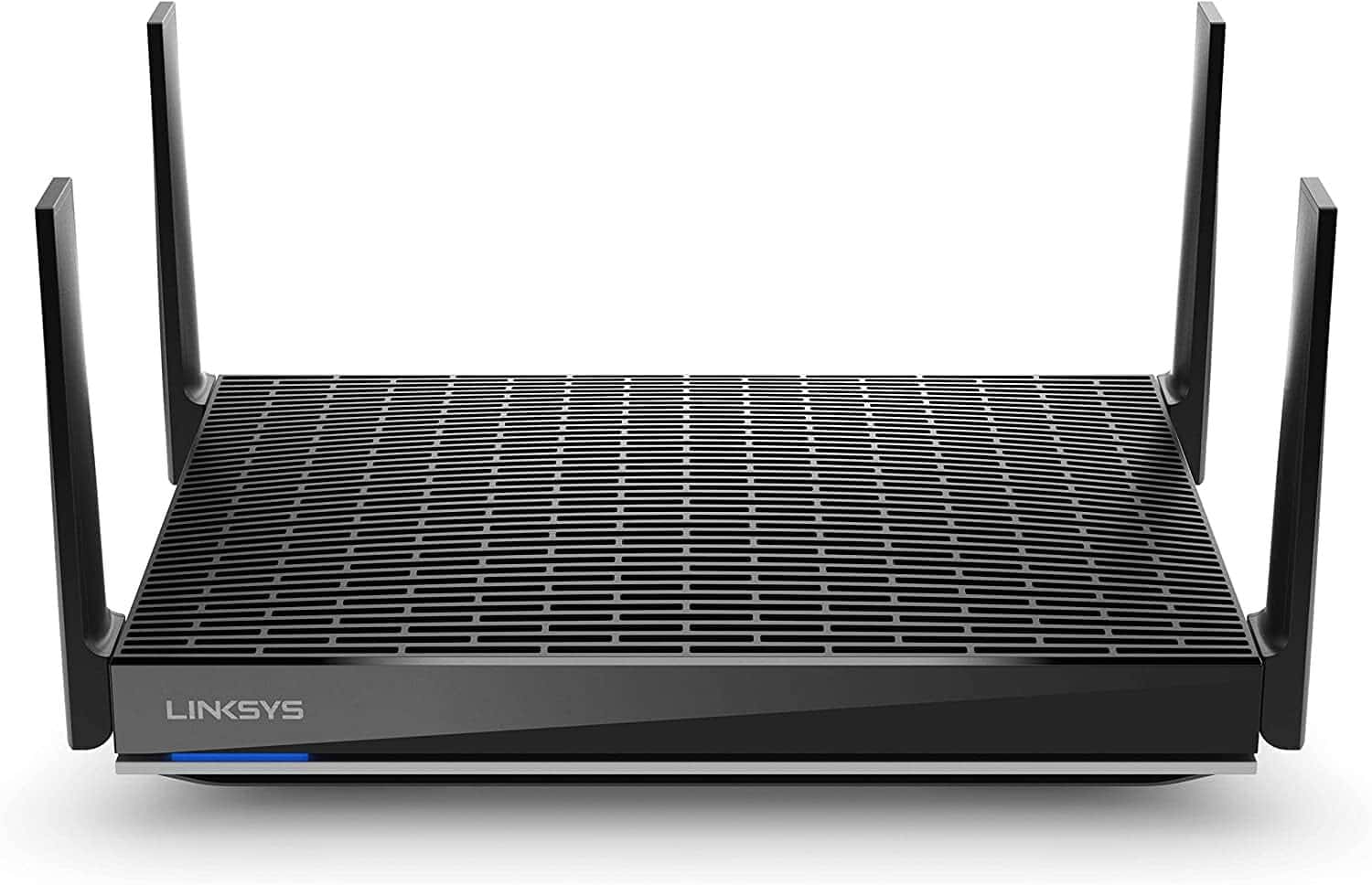
- WiFi Range: Up to 3,000 Sq Ft
- Wireless Standard: Wi-Fi 6 (802.11ax)
- Suitable Plan: Up to 1 Gbps
- 2.4GHz Speeds: 4804 Mbps
- 5GHz Speeds: 1147 Mbps
- Number of Devices Supported: 40+
- Ports: 1 x Gig WAN + 4 x Gig LAN + 2 x USB 3.0
- Processor: 1.8GHz Quad-Core
- RAM & NAND Memory: N/A
- App Support: Yes
Next on my list is a Linksys MR9610 dual-band WiFi 6 router that can get you speeds as high as Gigabit courtesy of its eight-stream capacity. Added to it, excellent coverage is possible due to its high-performance antennas. It can fulfill the bandwidth needs of most devices you have. These features make for a better upgrade than its older model, MR9600.
Why is it suited for a 3,000 Sq Ft House?
I replaced this router with my two-year-old Linksys MR900 Wi-Fi 5 tri-band router and was extremely impressed by its performance. Most network dead and weak zones were gone, and signals reached every corner of the 3,000 Sq Ft house, thanks to an equipped mesh tech. However, signals didn’t extend up to the garage, which demands using a WiFi extender.
Nevertheless, signal strength within the coverage area was powerful enough to fulfill the bandwidth needs of my 25 available devices. It is possible because of MU-MIMO and QoS integration that enables the router to deliver stable signals through walls. It was perfectly reflected in my gaming experience on multiple devices concurrently.
Wireless Speeds
So I had this Xfinity 1 Gbps plan, and the router seems to deliver great results with it. Over the 5GHz band, the download speed score was around 987 Mbps, while uploads transpired at 145 Mbps. At the same time, the respective speeds on the low-frequency band were around Mbps and 947 Mbps. This lets moving on with any internet-bound tasks with ease.
I put the router under stress by connecting it to heavy bandwidth-consuming devices like Xbox, PS5, and PCs and worked on light tasks like sending emails and streaming music. The device held true to the promises made, with minimal lags or latencies during the tests.
Wired Speeds
With 5 Gigabit ports (both LAN and WAN ports combined), your client devices could attain a maximum speed of 1.05 Gbps for downloads and 254 Mbps for uploads. So, your devices are now much faster with a wired connection.
Security Features
Security-wise, there are many basic yet helpful features to keep your network and devices safe. These include WPA3 mix protocol, guest network access, device prioritization, VPN server, and an automatic firmware update. Aside from that, it ingrains parental controls like manual website blocking, scheduling an internet pause, and activity monitoring.
Unlike TP-Link and Netgear devices, it offers no premium and advanced security features, so get a third-party antivirus installed if you need more security.
Conclusion
In conclusion, with powerful antennas, advanced wireless standards, and above-par performance, Linksys MR9610 qualifies as a good router for a 3,000 Sq Ft house. Its throughput capacity is excellent, and there were no significant signal drops during my tests.
However, its security features aren’t very advanced, and there aren’t any upgradable options available, which takes the router to the following position.
Pros
- Equips a mesh tech
- Easy to install
- Decent throughput capacity
- Speedy file transfer performance
- Great value for money
Cons
- Lacks malware protection
5. Best Mesh WiFi System: Amazon Eero 6+
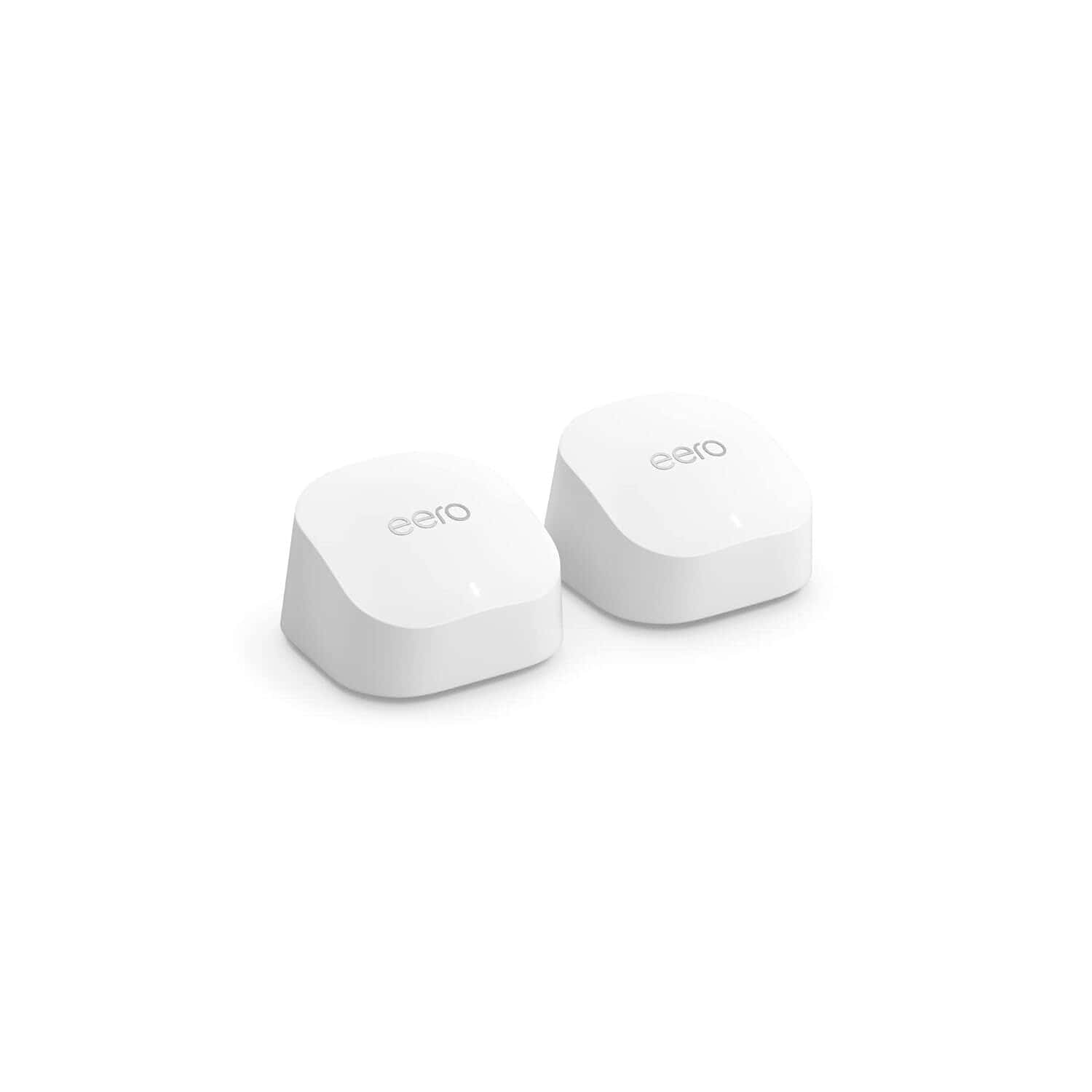
- WiFi Range: Up to 3,000 Sq Ft
- Wireless Standard: Wi-Fi 6 (802.11ax)
- Suitable Plan: Up to 1 Gbps
- 2.4GHz Speeds: 574 Mbps
- 5GHz Speeds: 2401 Mbps
- Number of Devices Supported: 75+
- Ports: 2 x Gig LAN
- Processor: 1GHz Dual-Core
- RAM & NAND Memory: 512MB + 4GB
- App Support: Yes
Mesh systems are a perfect solution if you want to eliminate those lingering network dead spots or weak zones in your two-bedroom apartment. Amazon presents you with an affordable Eero 6+ mesh router to cover a 3,000 Sq Ft house with seamless signals.
It's a significant upgrade to its flagship model, Eero 6, in terms of performance, coverage, and others.
Why is it suited for a 3,000 Sq Ft House?
Mesh systems are designed to get the signals to travel a few extra feet and let you connect some additional devices compared to the standalone routers.
And Amazon Eero 6+ does a decent job of getting your 3,000 Sq Ft space covered with decent signals. Courtesy of the nodes, signal strength was slightly higher than my previous recommendation.
Now coming to the connections capacity, there are technologies like MU-MIMO and QoS that circulates signals of similar strength to every corner and adds to the router’s ability to add more devices. I could connect over 40 devices at a stretch without interrupting the signal strength.
Wireless Speeds
With 802.11ax Wi-Fi 6 dual-band functionality and a maximum throughput of 3000 Mbps, I paired my 1 Gig Xfinity plan to get near-gigabit speeds on the client devices. And the results were quite optimistic.
The downloads and upload speeds over the 5GHz band averaged 875 Mbps, while the upload speed score was around 214 Mbps. At the same time, the speed output for the low-frequency 2.4GHz band was 315 Mbps and 75 Mbps, respectively.
The speeds on the distant band are much slower, but you can always connect to the 5GHz band and complete any bandwidth-intensive tasks in seconds.
Wired Speeds
Eero hasn’t been very lenient in this department, with two Gigabit Ethernet ports on each unit, where one is used to connect it with the modem. But you can always use the leftover port to plug in your client device and get access to even faster speeds. The maximum speeds for downloads and uploads were 975 Mbps and 250 Mbps, much higher than wireless speeds.
Security Features
Talking about what you get for free, WPA3, DHCP, and VPN passthrough stand out. Other than that, there are features like TLS v1.2+, port forwarding, static IP, and UPnP. That is more than what I expected from a budget-friendly mesh system, which can protect your network safe from unwanted threats.
But if there’s a lot of data and devices to protect in your large business ecosystem, upgrade your security with Eero Secure and Secure+.
Conclusion
Amazon Eero 6+ with decent hardware specifications combined with powerful antennas breeze through powerful signals throughout your entire space. You will get stable throughput and security features at this price bracket. But lesser speeds and other features pushed it down to the penultimate position.
Please read my full review of the Eero 6 Plus for more information.
Pros
- Wi-Fi 6 support
- Affordable price
- Great coverage
- Decent security features
- Great near-band speeds
- QoS and MU-MIMO
Cons
- Only two-port setup
6. Cheapest Option: ASUS RT-AX55
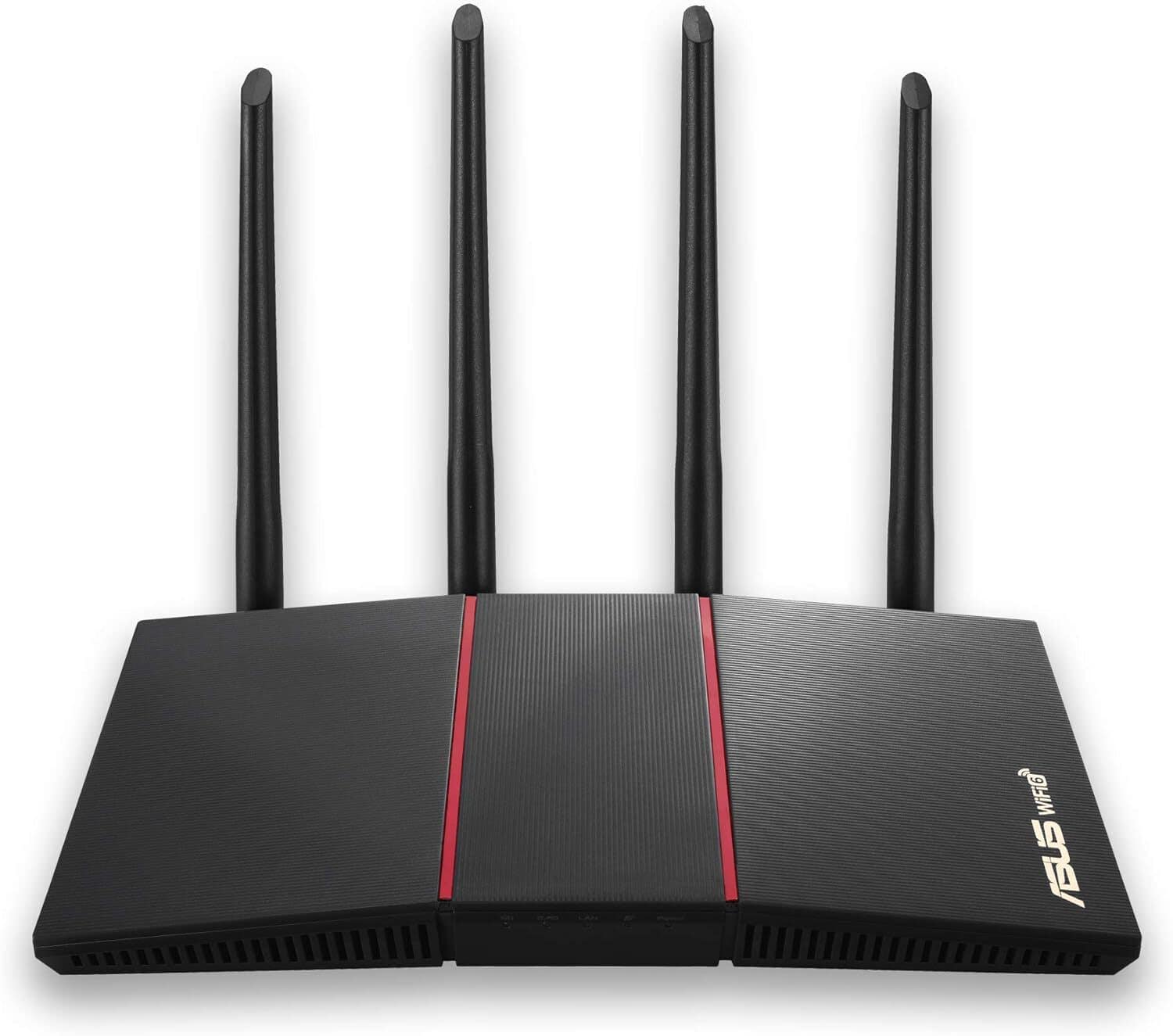
- Wireless Standard: Wi-Fi 6 (802.11ax)
- WiFi Range: Up to 3,000 Sq Ft
- Devices Capacity: Up to 30
- Band Frequency: Dual-Band
- Ports: 1 x Gig-E WAN + 4 x Gig-E LAN
The ASUS RT-AX55 is one of the most affordable WiFi 6 routers that still delivers dependable performance for basic internet use. It supports AX1800 speeds with 1201 Mbps on the 5 GHz band and 574 Mbps on 2.4 GHz. It includes standard features like MU-MIMO, OFDMA, and 160 MHz channel support. While it doesn’t offer mesh-level coverage out of the box, it worked well in testing for mid-sized homes. Setup through the ASUS Router app was quick, and the interface is easy to use.
This is a good option for households that want a budget router with enough range and speed for general use.
Why is it suited for a 3,000 Sq Ft House?
The RT-AX55 can cover most or all of a 3,000 sq ft house if placed centrally in an open floor plan. In my testing, it provided consistent signal across about 2,300 square feet. I used it in a one-story home with multiple rooms and only saw weak signal in two far corners. It handled streaming, browsing, and light gaming across the entire area.
If you're near the 3,000 sq ft range and have more obstructions or two floors, it might not reach every spot by itself. But because it supports ASUS AiMesh, you can add a second ASUS router later to expand coverage without starting over.
Wireless Speeds
I tested the RT-AX55 on a 500 Mbps fiber plan and got wireless speeds near 300–310 Mbps at 15 feet and 220–250 Mbps at 30 feet through one wall. That’s enough for 4K streaming, online gaming, and Zoom calls across multiple devices. Upload speeds stayed around 20 Mbps, which matched the plan’s cap.
The router supports 160 MHz channel width on the 5 GHz band, which helps when paired with newer phones, laptops, or consoles. While it’s not meant for high-end tasks or multi-gig speeds, the wireless performance is consistent across daily tasks.
Wired Speeds
The RT-AX55 includes four Gigabit LAN ports and one Gigabit WAN port. I used the wired ports to connect a gaming console and a PC. Both reached full plan speed with no drop in performance. Downloads, updates, and online games ran without delay. Ping stayed low during tests.
There’s no multi-gig support or link aggregation, but for gigabit and below plans, the ports work as expected. If you prefer a wired setup for a few key devices, this router supports that with no issues.
Security Features
This model includes WPA3, a firewall, and ASUS AiProtection Classic. It blocks access to known harmful websites and notifies you if any connected devices show unusual behavior. Parental controls let you set content filters or time limits for individual devices.
All controls are available in the ASUS Router app. You can pause WiFi, set up guest access, and update firmware without logging into a browser. There’s no extra fee for any of the built-in features.
Conclusion
The ASUS RT-AX55 is a very good option for homes around 3,000 square feet, especially if you’re trying to keep costs down. It delivers reliable speeds, decent coverage, and supports mesh expansion if you need more range later. While it’s not designed for high-traffic or multi-gig setups, it handles everyday TV streaming, browsing, and gaming without problems. For the price, it covers the basics well and is easy to set up and manage.
Pros
- Affordability
- Easy-to-use app
- Long WiFi range
- Lifetime free security
- Reliable performance
Cons
- No USB port
- Speed drops over a distance
Frequently Asked Questions
As far as my tests are concerned, the best pick for your 3-floor building would be Asus ROG GT-AX11000. This gaming router boasts advanced features like WiFi 6 tri-band support, powerful antennas, and other networking technologies to deliver an expansive coverage of up to 5,000 Sq Ft.
Mesh systems are the ultimate solution when you’re looking to cover up large spaces, but these are generally very expensive. Many standalone routers can easily fill up your 3,000 Sq Ft space at a price much cheaper than the mesh systems. So for a two-floored house, it’s smart to purchase a router rather than a mesh.
Modem router combo gets the functionalities of two devices into one, and therefore they might won’t boast features as advanced as in an individual device. And I haven’t seen any modem router combo with such an expansive coverage, which makes it unsuitable for the setup.
2.4GHz band has a longer range than its counterpart, 5GHz, and can penetrate solid objects more easily than the latter. So, for a house with zero interferences, a router set with 2.4GHz frequency can cover most 150 feet indoors and 300 feet outdoors. This might vary as interferences like thick walls, multiple networking devices, and others are introduced.
Here’s how you can boost WiFi in your 3,000 Sq Ft house:
– Install a wireless range extender to pair with your router
– You can choose to install an additional WiFi router
– Install a mesh WiFi system
– Get a Nighthawk mesh
Verdict
Although mesh systems best suit large homes, many standalone WiFi routers can send quality signals in a 3,000 Sq Ft home. However, picking one can be much more challenging than it seems to be. Reading through the curated list should help you pick your ideal choice. But if you still can’t decide, check these suggestions:
- Nighthawk RAXE500 is the best Netgear router for a 3,000 Sq Ft house that offers top-shelf features and performance.
- Get Asus ROG GT-AX11000 if you have many bandwidth-hungry devices and are invested in gaming, streaming, and other data-intensive tasks. It’s one of the fastest routers on the market out there.
- Amazon Eero 6+ is the go-to solution if you want seamless connectivity by establishing a mesh network.
- If you don’t want to spend much but need a reliable device, Linksys MR6910 is the best bet, courtesy of powerful antennas and a decent hardware setup.
I hope this helps you find an ideal router for your 3,000 Sq Ft house! The final decision should depend on the tasks, preferences, and internet plan you are subscribed to.


